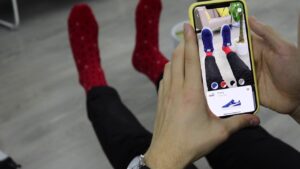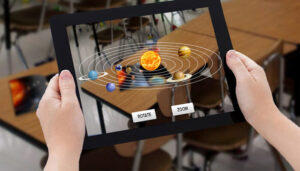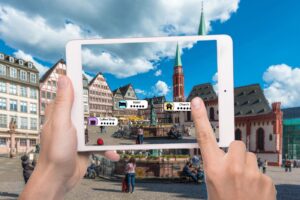What is Augmented Reality? Augmented reality (AR) is a superior version of the real world that is achieved through the use of digital visual elements, sound, or other physical stimuli delivered via technology. Particularly AR is a rising trend among companies that are engaged in mobile computing and business applications.
The evolution of Augmented Reality
Ivan Sutherland, a Harvard professor and computer scientist, invented AR in 1968. The name ‘Augmented Reality’, though, did not seem until 1990 as the technology really started to take off. During the 1990s, the USAF commenced using AR in training models, and NASA used AR to display map data on the viewing screen of its X-38 spacecraft directly. Not only professional life but also AR entered in everyday life of people. One of the best examples for that is, in sports, for helping viewers to understand the action, sports programmers used AR to overlay markers and arrows on the screen.
In recent times, companies that are having forward-looking, have begun to understand the concept of AR and its benefits in the business world. For the purpose of training employees in new roles or workflows, improving the safety of the workplace and at the same time, ideate and troubleshoot prospective challenges before initiating a substantial product launch or some investment companies are already using AR. Benefits similar to these are increasing the extraordinary growth projections for the AR market.
The Future of Augmented Reality
1. Augmented Reality in Healthcare

Because AR introduces several exclusive opportunities for patients and medical professionals, the healthcare industry will have much growth in the Augmented Reality market in future. Not only medical students using AR in their training programs to practice many techniques like surgical techniques but also doctors are being able to examine the vitals of a patient and refer to those images from MRI or CT scans during treatment periods. AR is very beneficial to link the gap between digital data and the medical professionals who make use of AR. And also, for the specialists and providers in areas who face scarcity issues, AR might have the ability to influence those access.
2. Augmented Reality in Shopping

In the retail market, AR will become an even larger part. Augmented reality lets consumers use their smartphones to understand further details about goods and make better selections that match their requirements. Vendors will be allowed wearable AR devices to send notifications and also bring a personalized shopping experience based on customer preferences.
3. Augmented Reality in Education

Augmented reality plays an important role in Education sector also as it’s becoming popular among institute which provides education nowadays. In future, it would be absolutely suitable for classrooms, because of Its interactive nature. Through this technology, materials such as books, worksheets and flashcards can be scanned. This technology is favourable not only for scanning available materials but also for getting to know about other sources and finding additional information. Further, this technology includes Interactive games and activities which are designed to strengthen key concepts. Therefore, it will be an effective learning mode for students.
4. Augmented Reality in Tourism Industry

There are already AR applications that have major impacts on the tourism industry. People can visit tourist websites that are popular with the help of AR technology, which gives a dynamic and interactive experience. During the visit to historical sites and museums, tourists will be permitted to bring AR apps and wearable AR devices for the purpose of learning every detail by scanning the area.
Top AR Tools for App Development
1. Vuforia
Vuforia an augmented reality SDK, which lies near the top of “Top AR” lists, with great reason. For the development of AR experiences, Vuforia provides various products, as well as Vuforia Engine, Studio, and Chalk. The establishment of both marker-based and markerless AR is supported by this software and has numerous key features which help it to become one of the best for object recognition and 3D modelling. The features consist of Ground Plane (to combine content to horizontal surfaces), Visual Camera (enlarges supported visual sources ahead of mobile phones and tablets), and VuMarks (custom markers which can be used in Vuforia for face recognition and encoding data).
2. Wikitude
This is one more good selection for AR software development. Although Wikitude is a newcomer to the market(The company foundation year is 2008), it has already gained a strong reputation. We can understand the quick growth of Wikitude from the debate of Vuforia vs Wikitude which has become very active in recent times. Wikitude is appropriate for developing AR apps for iOS, Android, and Smart Glasses devices. Wikitude supports a variety of tracking methods and technologies similar to the topmost AR development programs, although features geolocation, cloud recognition, and distance-based scaling features.
3. ARKit
ARKit is for the development of AR software developed by Apple, therefore android users are unable to use ARKit on their phones. For AR visualization, this software depends on camera sensor data and further data to identify and evaluate the surroundings of the user. Fast motion tracking, face tracking, Quick Look and various rendering effects are also supported by ARKit. ARKit tutorial materials and updates along with each new version of iOS are being released by Apple.
4. ARCore
ARCore is in various ways an analogue of ARKit which is another application developed by the creators(Google) of a platform(Android) for devices using ARCore. ARCore comes up with the standard bundle of AR features such as motion tracking, surface detection, light estimation, along with some advanced features like augmented images (customize responses to exact types of 2D shapes and objects) and multiplayer (version of the same 3D objects on various kinds of devices concurrently. ARCore is similar to Vuforia, which lets the users get the greater functionality suggested by the 2 categories of software at once. Furthermore, to build effective Android apps, and ARCore Unity pairing is frequently applied.
5. ARToolKit
ARToolKit is an open-source and free SDK that is available for AR development for devices on various platforms. Aside from iOS and Android, ARToolKit is applied for AR apps on Windows, Linux, and OS X. ARToolKit was released in 1999 and has several updates till now. A few features contained in the newest build are, tracing of planar images and simple black squares, natural feature marker generation, real-time speed support, and easy camera calibration. For the development with Unity and OpenSceneGraph, ARToolKit comes up with some optional plugins.
Conclusion
In the upcoming years, the usage of augmented reality technology will arise by a huge amount. In the future, the development of AR wearable devices, that can provide complete play to the advantages of augmented reality technology, will establish a realistic combination world. AR technology can interact with people in a real way of human-computer interaction.

